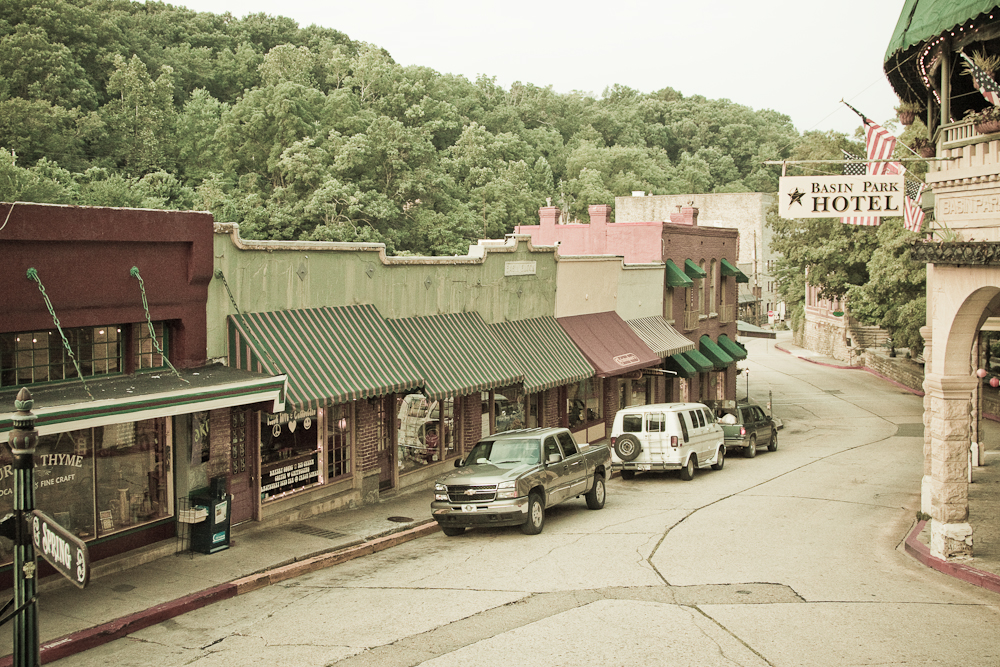

The year 1879 marks the genesis of Eureka Springs. Situated eight miles from the southern Missouri border on Leatherwood Creek, a branch of the White river, this isolated area in the Northwest Arkansas Ozark Mountains became one of the more popular health centers in the United States. Visitors were attracted by the number of mineral water springs, believed to have therapeutic value for many of the prevalent diseases. The springs medicinal qualities were discovered by Dr. Alvah Jackson in 1858. Apparently Dr. Jackson did not reveal the source of his famous “Dr. Jackson’s Eyewater” until 1879. In that year the doctor advised his good friend, Judge L. B. Saunders of Berryville, to try the springs as a final attempt in curing a bad case of erysipelas, a skin disease that caused extended inflammation. The positive results gained from the springs prompted Saunders to spread the word of the medicinal qualities of the water in and around the area later named Eureka Springs.
Eureka Springs became a resort almost overnight. Along with this popularity came a hodgepodge of private and commercial housing, much of it tents, shanties and leantos. The majority of the structures were hastily built for immediate occupancy rather than stability, to secure lots as close to the springs as possible. Thus the concentration of settlement developed around the various springs in the area. Unlike the development of building patterns in most towns, where the most desirable living areas were on the higher elevations, property values were based on the proximity to the springs. Consequently the wealthier segment of the town’s population settled in the lower areas nearest the springs while the less wealthy population lived in the higher area, farther from the springs.
The economy of Eureka Springs developed around the springs. The springs brought in tourists as well as people with health afflictions with the result that profitable business of hotels, saloons, bathhouses, dry goods stores, groceries and liveries sprang up. The attraction of the springs also brought the investors and the railroad. During this time the Eureka Improvement Company had a major influence on the development of Eureka Springs and its built environment. The company, organized in 1882 by former Arkansas governor Powell Clayton and other enterprising investors, reflects Eureka Springs’ most illustrious period, the “era of big promoters”. These men invested heavily in the development and promotion of Eureka Springs as a health center and a retirement place for the wealthy. During this era, 1880 – 1890, Eureka Springs reached its peak in popularity, wealth and gracious living.
The Eureka Improvement Company can be credited with at least two major contributions to the development of the town as a popular resort. The first was funding and constructing the Eureka Springs Railroad. In 1880 the nearest railroad terminal was the St. Louis and San Francisco Railroad depot in Pierce City, Missouri, 55 miles from Eureka Springs. The people coming to the springs had to depend on a nine hour coach ride from Pierce City to complete the trip. The following year the railroad line reached Seligman, Missouri, only 20 miles from the resort area. Seeing the need for a railroad line into Eureka Springs, the Eureka Improvement Company began promoting and planning for what became the Eureka Springs Railroad. Completed in 1882, the railroad brought great prosperity to the town not only in the health trade but in the commercial industry as well. The railroad terminal was the nearest depot for the isolated counties to the east and southeast. Therefore, Eureka Springs became an important commercial center for the area. Another benefit, in connection with the railroad was the establishment of a St. Louis and San Francisco Railroad shop. The benefits of the railroad and its running of as many as six trains a day seemed to assure the future economic success of the town.
The second contribution of the Eureka Improvement Company was the company’s activities and participation with the city council in improving the living environment of Eureka Springs. Most of the early housing was poorly constructed with no stone or cement foundations. These structures were supported by wood piers. Four major fires swept through various parts of the community, and the condemnation and demolition of the structures in the 1890‚Äö√Ñ√¥s destroyed many of the early frame structures that represented the founding and early growth of Eureka Springs. Through investment in the town, the Eureka Improvement Company encouraged and erected more substantial buildings. Brick and stone, particularly limestone, sandstone, granite and marble quarried from the surrounding vicinity, were now included in the construction fabric. The company also encouraged the widening of the streets, the installation of street lights, water and sewage systems and wooden sidewalks. Granite and limestone walls were used to terrace the hillsides for construction and landscaping.
By the turn of the century, Eureka Springs stood at its apex of prosperity. However with the coming of the twentieth century the economic future of the town began to decline gradually. A new positive attitude was forming toward science and its discoveries in the field of medicine. As society gained more confidence in modern medicine, the faith in the curative power of the mineral springs diminished as seen in the decline of Eureka Springs as well as other resort areas in the country. The railroad also dealt a blow to the local economy. In 1911 the St. Louis and North Arkansas Railroad connected Eureka Springs with Harrison to the east, lessening the town’s importance as a commercial center. Thirteen years later, the railroad moved its shops out of Eureka Springs and transferred them to Harrison.
However with the advent of the car, Eureka Springs was able to survive by promoting its recreational attractions along with its well known springs. In the 1920’s auto tourism developed as a principle source of revenue for the local economy. The depression took a heavy toll on the town’s built environment. Buildings were abandoned or torn down to sell the wood. Vacant lots became more common. But hard times also proved beneficial to Eureka Springs. The nation began to develop a nostalgia for what was perceived as a happier and more successful time, the turn of the century. The arts began to use country themes in order to identify a more wholesome type of life. Eureka Springs offered such an environment for artists and writers as well as a less expensive and simpler lifestyle. After World War II Eureka Springs continued to attract artists and writers.
In 1970 the entire town was placed on the National Register of Historic Places.
Quoted from cityofeurekasprings.org